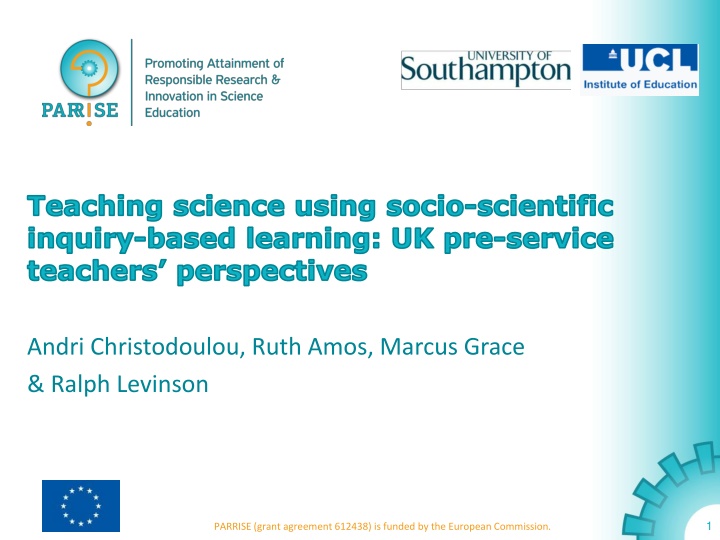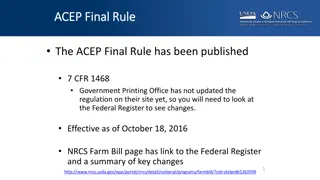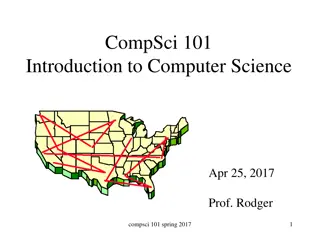
Perspectives of UK Pre-service Teachers on Socio-scientific Inquiry-based Learning
Explore the perspectives of UK pre-service teachers on utilizing socio-scientific inquiry-based learning in science education. Understand the challenges, beliefs, and practices influencing their engagement with SSIBL and its enactment. Discover the role of professional development in enhancing teaching practices.
Download Presentation

Please find below an Image/Link to download the presentation.
The content on the website is provided AS IS for your information and personal use only. It may not be sold, licensed, or shared on other websites without obtaining consent from the author. If you encounter any issues during the download, it is possible that the publisher has removed the file from their server.
You are allowed to download the files provided on this website for personal or commercial use, subject to the condition that they are used lawfully. All files are the property of their respective owners.
The content on the website is provided AS IS for your information and personal use only. It may not be sold, licensed, or shared on other websites without obtaining consent from the author.
E N D
Presentation Transcript
Teaching science using socio-scientific inquiry-based learning: UK pre-service teachers perspectives Andri Christodoulou, Ruth Amos, Marcus Grace & Ralph Levinson 1 PARRISE (grant agreement 612438) is funded by the European Commission.
PARRISE: Promoting Attainment of Responsible Research and Innovation in Science Education SSIs, IBSE, CE Responsible Research & Innovation (RRI) 2
What do we know about how pre-service teachers use SSIs, and IBL in their teaching? PSTs reasoning and argumentation varies when learning about SSIs (Topcu et al., 2010) disconnect between the relatively mature conceptualizations of effective SSI instruction and classroom practice on the topic of genetically modified crops (Gardner & Jones, 2011) PSTs personal beliefs about teaching and about science can affect their engagement with inquiry-based learning practices (Crawford, 2007) Beginning teachers change beliefs about teaching & learning more than teaching practices when taking part in CPD about inquiry-based learning (Luft, 2001) 3
Professional Development in Science Education (van Driel et al., 2012) focus of PD intervention should be clear for the teachers; teachers should engage in active and inquiry-based learning being active participants in the process collaborative learning elements should be included, with teachers learning with and from each other; duration and sustainability where teachers are being supported over a period of time to ensure the effectiveness of the intervention; coherence with curriculum reforms and policies needs to be clear for the teachers, and finally, school organisational conditions need to be accounted and dealt with
Teacher as learner of SSIBL Teacher as designer of SSIBL Teacher as user of SSIBL Teacher as researcher of SSIBL Teacher as reflective practitioner on SSIBL Teacher as learner, designer, user of SSIBL
Research Question What are UK pre-service teachers perspectives on SSIBL and on its enactment as they learn to teach science? 6
Lesson plans, resources & reflective evaluations (105); pupil materials Methods Across 3 academic years Focus groups discussions (4) 404 PSTs across two institutions Reflective essays on aspects of SSIBL (A1/24 +A2/21) Biology, chemistry and physics specialists that teach all subjects Individual interviews (7) Lesson observations (11) 7
A) Analysis of teacher resources a) How were topics contextualised into authentic scientific questions and inquires, b) How SSIBL was enacted using strategies such as mapping controversies of SSIs, deliberation and discussion, scaffolding inquiry and considering the nature of science c) How taking action was represented in teachers and students work as this emerges from students inquiry. 8
PST18 Cycling to school; Health, Muscular systems Groups of students designed a questionnaire to explore possible solutions for increasing cyclists Explore road outside school for dangerous areas; link to other cities/countries Analyse findings, draw conclusions Action taken: Present findings about solutions to classmates write a report and give to school s student council for them to feed to teachers and local council Stimulus question: Why do only 3 out of 1300 students cycle to school? Guided inquiry (2 lessons) 9
PSTs enactment of SSIBL lesson materials SSIBL materials more frequently designed for younger age groups (Year 8; 12-13 year olds) Majority focus on Biology topics (~50%) 10
PSTs enactment of SSIBL lesson materials Tension between designing and implementing student- centred learning environments Authentic questions placed students in the centre of the learning process (e.g. how can our school can do better looking after the environment? How can the school reduce the amount of waste plastic bottles? Why do only 3 out of 1300 students cycle to our school?) Guided inquiry approach preferred (Vs. structured or open; teachers give students the question to investigate) Role-play, debate and group work activities included where debates are used PSTs note that this is a new experience for them as they have not had the opportunity to use it before in their teaching Operationalising RRI through Taking action varied in form and level of ownership assigned to students 11
3 levels of taking action represented in PSTs planning and implementation of SSIBL Level 1: Raising awareness about an issue (e.g. make a poster to detail your findings ) Level 2: Intention to Act on the issue (e.g. debate about what should be done about a new wind farm constructed; making a decision on a given scenario what would you do as doctor/patient/family member) Level 3: Taking Action (e.g. making a presentation to older students to convince them to not drink sugary drinks; creating a survey to investigate a topic - e.g. smoking; Write down pledge and name of someone to be accountable for that) 12
PSTs views on the value of SSIBL Beliefs about teaching & learning They [students] don't get any time to link it [science content] to the real world so maybe if you took the time to put the creative effort on it and made it all more real for them then they would actually enjoy science more and then maybe they would get a better grade because they retain more of it (PST8, focus group Nov15) 14
PSTs views on the value of SSIBL Beliefs about teaching & learning So I thought it was quite interesting and I think kids are more engaged with it, they don't think oh science is boring, I need to do an experiment and write it up and then it's done' but why is that science important to you? So I think that's why I chose it [SSIBL] because I think it can make science lessons a lot more engaging and then hopefully have kids and a generation a little bit more, engaged with the science and more willing to see how it links to them (PST9, interview Mar16/SOTON). 15
PSTs views on the value of SSIBL Prior experiences as learners of science it s [SSIBL] the only way to go forward really, I'm really quite passionate about science but I found it really boring at school (PST/SOTON, focus group Nov15) We did a lot of the traditional experiments that you would do. We did, a lot of people would write things on the board, we would copy it into our books. We d do practice calculations. There wasn t a lot of explicit, Investigate this and find out . [ ] It was a fairly traditional style of learning (PST22, interview May17) 16
PSTs views on the value of SSIBL Experiences as teachers of science It [SSIBL lesson] was quite interesting because they were quite low-ability classes. Even the high ability, I would say, is quite a low-ability class. And they love the lessons. I saw them the following week, and they all said, Oh sir, can we do that again? [ ] I think as it got them all engaged, they all had to be thinking, they couldn t switch off because I randomly chose people to get involved in the answering of the questions (PST24, interview Apr17) 18
PSTs views on the value of SSIBL Pupil characteristics The discussion was almost completely student-led, and the students carried this out in a mature manner. This was unpredicted by the low ability class who often were immature and would not accept differing opinions in lessons prior to this (PST24, writing task, May17) [I] would have to have time to train children into how you wanted them to carry out a particular task (PST9,survey) [it s a challenge] ensuring that all students are engaged at all levels (PST20,survey) 19
Perceived challenges in developing SSIBL competencies Resources (e.g. time, materials) Alignment with National Curriculum Support provided by experienced teachers/in-school Understanding the SSIBL framework Teaching skills (e.g. questioning, differentiation, setting up groupwork) Pupil characteristics 21
Challenges I have witnessed for myself how the interest of the students increases. I also believe giving students the opportunity to explore the range of thinking and skills associated with science is more important than just teaching them facts to regurgitate. However, I have also experienced how hard it is to always incorporate this into your teaching, especially when battling with meeting the high demands of the curriculum (PST9S, written task 1, Jan16) 22
In school support When I discussed inquiry-based learning with experienced teachers at my placement school, most admitted to not really being clear on what it entails. After discussing what it involves, most agreed that an inquiry-based lesson would engage their students. However, the consensus was that the time constraints under which they worked would make it difficult to plan and prepare for such lessons (Round 1 TPD/UCL). 23
Discussion SSIBL in action made a positive difference to PSTs perceptions and attitudes towards SSIBL Pupil engagement and interest in SSIBL lessons taught was noticeably different by PSTs More chemistry and physics SSIBLs emerged in 2nd Year of project when encouraged, although Biology was still the most common context used PSTs views on Engagement and Relevance guide PSTs motivation and sense of agency in using SSIBL PSTs perspectives on good science teaching and learning were consistent with the SSIBL approach 24
Conclusions & Implications PST need to have opportunities in early years of career to develop SSIBL pedagogy for sustainability Teacher education about SSIBL needs to be considered in combination to science teacher identities consistent with such an approach (Eick & Reed, 2002; Avraamidou, 2016) Work more closely with PSTs on identifying critical moments in their training or experiences that help them form teaching practices consistent with the use of SSIBL in science education Biology topics seemed to be a good starting point 25
Thank you for listening! A.Christodoulou@soton.ac.uk Ruth.Amos@ucl.ac.uk 26












